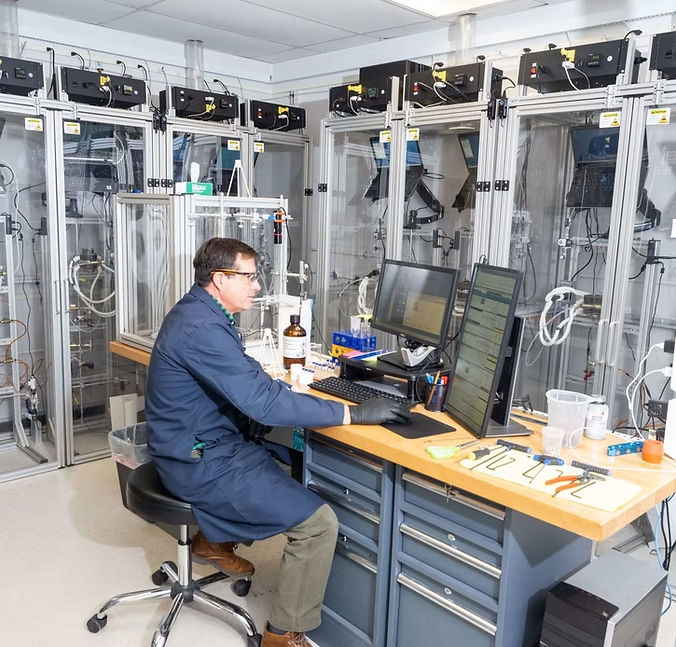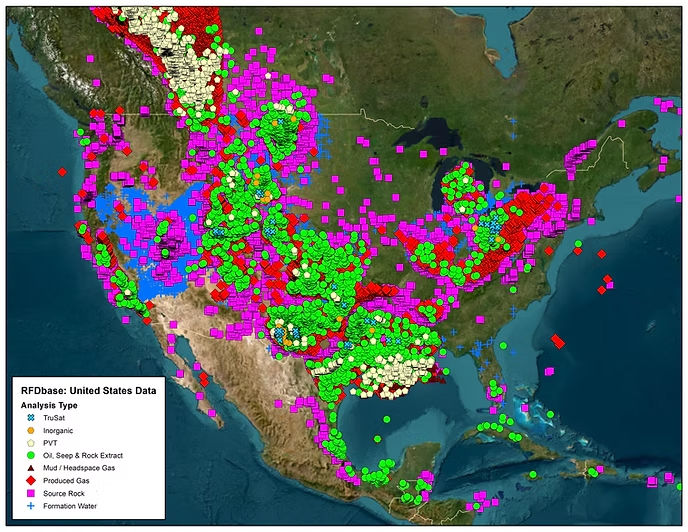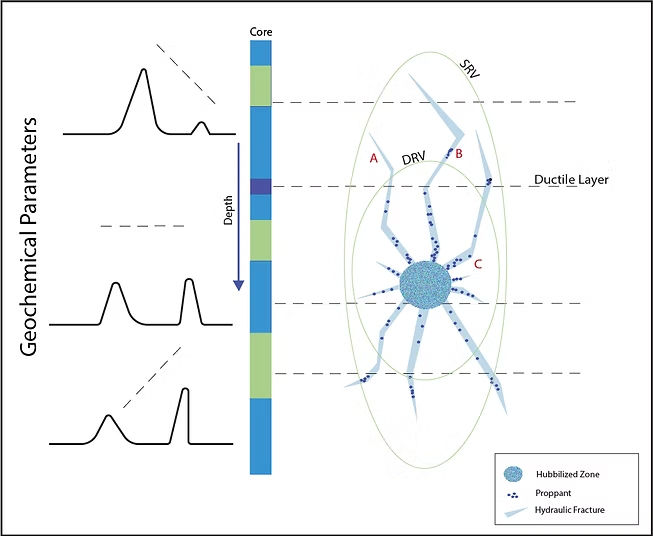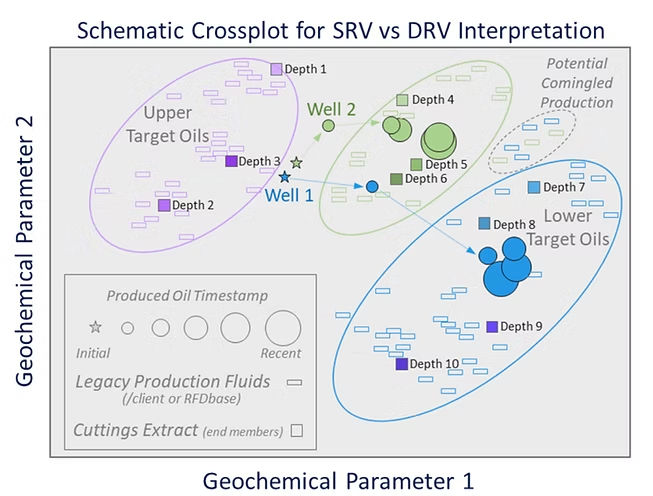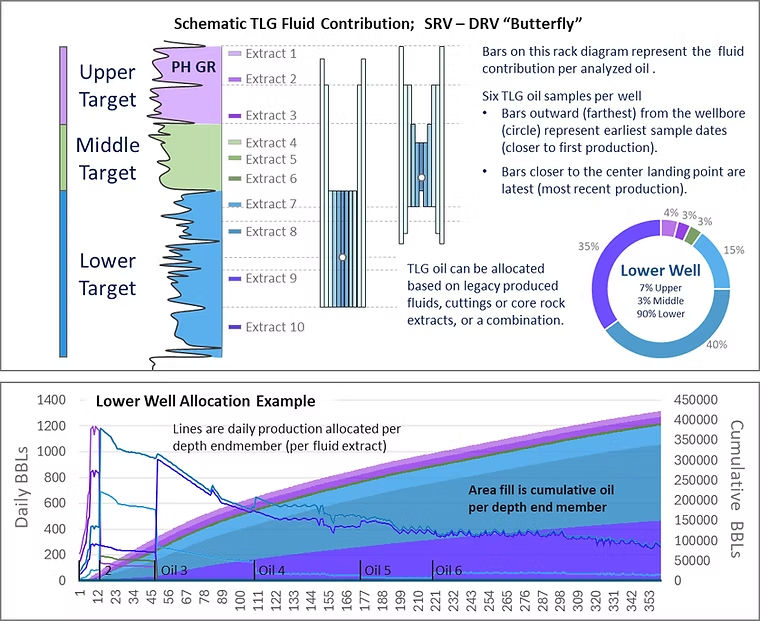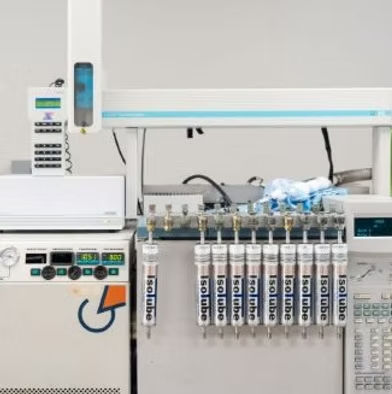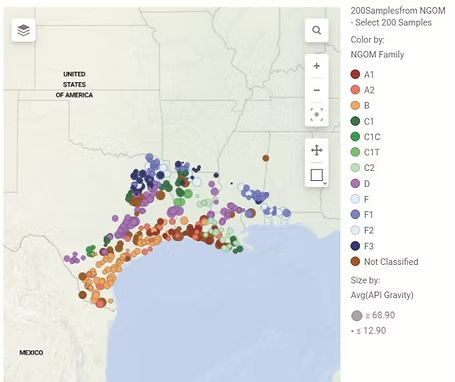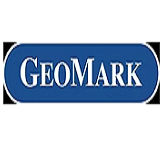
GEOMARK RESEARCH, LTD.
Houston, Texas, United States
GEOMARK RESEARCH, LTD.
!
PROVIDING QUALITY GEOCHEMICAL AND PVT DATA, FROM A SOURCE YOU CAN TRUST. SCIENCE, DONE RIGHT.
About GEOMARK RESEARCH, LTD.
Your Source for Comprehensive Production Allocation, Geochemical & PVT Solutions.
Our Vision
To have GeoMark data used and valued by all companies with geochemical needs
Our Mission
Providing quality geochemical data and knowledge from a source you can trust. Science, done right.
Description of Services
1). Laboratory Services
Get Accurate Data FAST
Today’s fast-paced market requires quick results and accurate data to make reliable hydrocarbon decisions in a timely manner. GeoMark is dedicated to the advanced measurement of high-quality analytical results.
We perform a range of rock and fluid analyses, including detailed biomarker oil analysis, source rock analysis, gas analysis with carbon isotopes, rock properties analysis, and PVT analysis. Whether you’re drilling an unconventional horizontal well in the Permian Basin, or a deep water well in Walker Ridge, we are here to deliver accurate data in a timeframe that meets your needs.
2). Production Allocation
Reservoir Geochemistry for Development and Production Optimization.
Spend Less, Produce More with GeoMark
What Is Production Allocation?
When developing an asset efficiently and effectively, many questions can be answered using Production Allocation. During the development phase, routine geochemical sampling and analyses provide insights into whether the frac energy is appropriate concerning the amount of fluid accessed from day 0 to the present. These insights enable reactive development (well stacking and spacing) and production decisions (choke management, shut-in, pressure management) to optimize individual well or pad performance while minimizing hydrocarbon stranding.
Contributions: The identified collection of distinct source components of a fluid reaching a wellbore per formation, subzone, or geologic regime as defined by geochemical variance. We typically refer to single oil assessment as “Characterization.”
Allocation: The quantified contributions of discrete fluid sources can be allocated for individual fluid samples or integrated with total fluid production volumes to understand the total amount of fluid from each individual source component.
What Questions Can We Answer?
- Is production isolated to a single target?
- How does the Drained Rock Volume (DRV) change over time?
- Geochemistry can indicate or challenge fluid communication between wells, quantify communication between targets zones, and detect the impacts of offset production or operations.
- Are we leaving hydrocarbon behind?
- Is our development plan efficient and effective?
- What is your value of knowing the precise stratigraphic contribution of oil, water, or gas through time?
- Can we extract more value from our hydrocarbon product?
The GeoMark Difference
With over 30 years of experience, GeoMark offers more than just data. Backed by the industry’s largest geochemistry, gas, and PVT database (RFDbase), we provide data enriched with enhanced statistical analysis, expert geochemical knowledge, and regional geochemistry insights.
At GeoMark, we focus on the entire fluid system. We understand the importance of incorporating oil, gas, and water in our interpretations of well-to-well communication and stranded reserves. Our extensive toolbox and flexible approach allow us to tailor our analytical programs to the specific fluid system type (e.g., high maturity) and the unique questions our customers need answered.
We believe in transparency and reproducibility. Unlike black box workflows, our data interpretation is clear, repeatable, and explainable, empowering our customers to replicate and enhance their interpretations with their own data.
As a geochemistry company, we deliver comprehensive datasets that can be used for Time-Lapse Geochemistry & Production Allocation interpretations and to address petroleum systems questions such as hydrocarbon sources and migration. Why spend more on additional analyses?
How Effective are your Completions?
The image illustrates the advantages of examining the current state of a frac by visualizing the extent of the drainage heights once the wells have leveled out. This example schematic shows several "zones" under development, indicating where the fluid is coming from and whether more wells are needed to maximize production. Stimulated Rock Volume (SRV) methods often overlook the effects of unpropped "wet-frac" zones (A) and stranded well-propped fracs due to rapid fracture healing (B). In contrast, geochemical measurements directly assess the well-propped drainage zone (C), and comparing these measurements with baselines such as core, SWC, cuttings, or produced fluids can inform drainage heights.
This schematic also demonstrates the impact of monitoring SRV versus Drained Rock Volume (DRV) over time, providing a clearer picture of subsurface well interactions and answering questions like "Has well interaction changed over time?" and "Are new fracs needed to maximize production?"
This schematic below demonstrates the impact of monitoring SRV vs. DRV overtime as it can paint a clearer picture of what is happening with wells beneath the surface, and answering questions such as "Has well interaction changed overtime?" and "Are new fracs needed to maximize production?"
Contribution and Allocation
- New well oil production can be allocated based on legacy produced fluids, cuttings or core rock extracts, or a combination.
- Allocations based on produced fluid baselines can be robust for formation or group contributions- allocation can be assigned mathematically or estimated geometrically.
- Allocations based on rock extracts can be more precise for higher resolution statistical allocation assignments.
Visualize Your Well's Performance
Through routine geochemical sampling and analysis, it becomes straightforward to monitor the drained rock volume and allocate production volumes throughout each well's life. GeoMark’s Production Allocation customizable dashboard offers operators the tools needed to effectively assess each well's performance in relation to the formations it is draining. This information also provides insights into potential well communication.
Another useful application is the allocation of produced fluids for each well. By allocating total fluid production to specific formations, operators gain valuable insights for potential refrac or infill well developments. Here are some key noted on fluid contribution and allocation:
-
New well oil production can be allocated based on legacy produced fluids, cuttings or core rock extracts, or a combination.
-
Allocations based on produced fluid baselines can be robust for formation or group contributions- allocation can be assigned mathematically or estimated geometrically.
-
Allocations based on rock extracts can be more precise for higher resolution statistical allocation assignments.
3). PVT And Mud Gas Analysis
Pressure Volume Temperature (PVT) Analysis
RESERVOIR FLUID BEHAVIOR & PROPERTIES
PVT SERVICES
- Field sampling and wellsite services
- Sample transfer, validation and restoration
- PVT tests up to 20,000 psi and 400 degrees
- Reservoir fluid phase identification
- Surface separator fluid recombination
- Constant Composition Expansion (CCE)
- Differential Liberation (DL)
- Constant Volume Depletion (CVD)
- Multi-stage separator test
- Pressurized and Stock Tank fluid viscosities
- EOR – Minimum Miscibility (Slim Tube), Swelling and Multi- contact (reverse and forward)
- Flow Assurance - Asphaltenes and Waxes
- Long-term pressurized sample storage
- Working pressure maps
- PVT Cylinder Storage (Short and Long term)
GeoMark Research’s established PVT laboratory has been serving the industry for over 15 years, providing critical subsurface fluid insights for our global customers:
- Fluid Phase Prediction: Predict when in-situ fluids will hydrocarbon insights)transition to multiple phases (bubble point and recoverable
- Well Interactions: Evaluate how parent-child relationships are affecting PVT behavior
- Reservoir Continuity & Communication: Pressure assessment to identify reservoir communication
- Production Management: Fluid property assessment for choke management and production infrastructure optimization
The GeoMark Advantage
Our specialists combine engineering and geochemical analyses to effectively expand our understanding of reservoir fluids.
With the integration of PVT and Geochemistry, we can evaluate reservoir continuity between wells. Oils in compartmentalized
reservoirs usually differ in molecular composition caused by biodegradation, multiple charge history etc., and can explain
the differences in fluid properties. The variations in composition can be identified using high resolution whole crude Gas
Chromatography (GC) which separates the many molecular components in petroleum. The resulting “fingerprints” from each
zone are compared visually and with more complex multivariate statistical techniques to determine the similarities and
differences between samples.
Mud Gas Isotopes
GEOCHEMICAL CHARACTERIZATION
GeoMark Research’s established Mud Gas Isotope laboratory has been serving the industry for over 15 years, providing timely and trusted gas analysis data from exploration and production wells around the world. Our data provides insights to the following:
- Gas Compositions: Cost effective screening technique to quickly identify hydrocarbon bearing zones
- Gas Classification (Biogenic vs. Thermogenic): Helps determine the source of gas encountered within a well
- Maturity and Mixing: Evaluates delivery of gas source maturity and relative mixing between thermogenic and bacterial (insights to migration)
- Wetness: Identifies dry gas, condensate, or oil throughout the well
- Connectivity: Assesses if reservoirs are connected or sourced from the same source
- Helium: Exploration of alternative natural resources
The figures below present a selection of data outputs and interpretations that can be made from Mud Gas Isotope Analysis. Stable gas isotopic data (methane, ethane, propane and higher molecules) have traditionally been used as geochemical source and maturity markers and to indicate the relative concentrations of biogenic and thermogenic components in reservoir fluids. Collected over multiple wells, this data can be used to evaluate continuity between different zones in single and multiple wells; connected reservoirs should have similar isotopic values.
MUD GAS ANALYSES
- GC Compositions to C6+ including He, H2
- GC-IRMS Methane (C1) Carbon Isotope Compositions
- GC-IRMS Ethane (C2) Carbon Isotope Compositions
- GC-IRMS Propane (C3) Carbon Isotope Compositions
- Butane (normal & iso) Carbon Isotopes
- Pentane (normal & iso) Carbon Isotopes
- Deuterium Hydrogen Isotopes
- CO2 Isotopes
4). Geochemistry Consulting
Overview
GeoMark Research has the knowledge, resources, and ability to provide integrated geochemical support, covering the full range of operator needs in both conventional and unconventional opportunities. A fully equipped geochemistry laboratory, in combination with an industry-leading staff of senior analytical and interpretive petroleum geochemists, is equipped to deliver practical solutions to optimize your exploration or production project.
Project Design & Collection
All Geochemical Consulting projects begin with an overall project design and the collection of gas, fluid, and/or rock samples to be analyzed.
Capabilities & Deliverables
We provide the following Project Design and Collection general capabilities and specific deliverables for each step in this “getting started” process:
Project Design & Scope
- Define geochemical project goals
- Plan overall pad, field, and basin-wide sampling scope and context (gas, fluid, and rock)
- Identify required timing and frequency of sampling program
- Confirm additional data which can be integrated into the geochemical program
Core/Cuttings Sample Selection
- Advise on initial core/cuttings screening process for the geochemical program
- Define requirements for the cuttings/core selections to meet project goals
Gas & Fluid Collection*
- Outline fluid (water and oil) and gas collection protocols
- Identify training requirements if operator is sampling directly
*GeoMark can coordinate and collect fluid and gas samples as part of the project scope.
Interpretation Services
Overview
GeoMark’s Geochemical Consulting services include single sample, multi-sample, or basin scale interpretation capabilities. Specific outputs and direction can be customized based on the goals and concerns of the operator.
Data in Context
The Rock & Fluid Database (RFDbase) system at GeoMark Research and the regional studies housed within it (e.g. Permian Basin, Mid-Continent, Gulf of Mexico, Colombia Oils, etc.) allow a broader regional context to be applied to operator sample sets.
Deliverables
These deliverables are applicable across the business lifecycle of your project:
- Full geochemical characterization
- Source potential and richness
- Organofacies determination
- Comprehensive rock, fluid, and gas maturity assessment
- Source rock-oil correlation assessment
- Oil-oil correlation assessment
- Statistical modeling of operator samples within a regional framework (provided from RFDbase)
- Customized field scale statistical analysis (baseline geochemical assessment)
- Age determination
- Production monitoring (TLG)*
- Potential fluid contribution and mixing assessment*
*Production monitoring and allocation deliverables are offered specifically as part of GeoMark’s Reservoir Geochemistry Solutions packages.
Consulting & Collaboration Services
GeoMark executes our Geochemical Consulting services as an active member of your project the team. We collaborate closely with you to understand the critical scope and goals of the project, and provide a truly integrated product. From our vast experience, we are able to adapt to challenging asset requirements and evolving changes. Nothing is too big or too small—from Pre-Screening Acreage Assessment to Exploration-Exploitation (Appraisal) and Development focused projects.
Deliverables
Our collaborative project deliverables include:
- Acreage assessment
- Exploration screening (gas, fluid, and rock)
- Regional context study
- Exploitation-appraisal
- Production monitoring and fluid contributions
- Integration of existing geochemical datasets
- Advanced statistical modeling implementation/integration
- Integration of geochemistry into operator’s other specialist services
Integrated Geochemical Studies for Operators
Based on the gas/rock/fluid samples collected and the analyses performed in GeoMark’s laboratories, we can generate integrated geochemical studies for your particular needs and area of interest.
Study Contents
Our integrated studies contain any/all of these topics:
- Rock data integration (core, sidewall core, cuttings)
- Fluid and gas data integration (crude oil/condensates, mud gas, produced gas, and production/frack waters)
- Geochemical framework — source and produced oil in context of client samples
- Source rock generative potential maps, maturity modeling, and production “sweet spot” (with mapping)
- Risk assessment of original source, migration, and preservation
5). Subsurface Databasing
RFDbase™
THE INDUSTRY’S LARGEST ROCK, FLUID, AND PVT DATABASE SOURCE ROCK – OIL – GAS – PVT – WATER – XRD – XRF – ICP-MS - TRUSAT
If you are a current RFDbase subscriber, or you would like to register for demo access, please click the login button to enter the RFDbase homepage.
GeoMark Research’s on-demand rock, fluid, and PVT data delivers data-driven decisions for discovering and managing earth’s natural resources.
For the past 30 years, this exclusive, curated dataset, has been trusted by energy professionals around the world. Just as our industry evolves to meet new energy demands, RFDbase continues to grow in depth and breadth. From hydrocarbon production to critical mineral exploration, trust RFDbase to provide the quality data you need
The GeoMark Research Advantage
Integrate your proprietary data with ours to create quality data science trends for rock and fluid properties, spatial mineralogy, and operational vs geological analysis.
Eliminate the hassle of finding, gathering, and cleansing data. Gain immediate access to a trustworthy dataset comprised of more than 500,000 oil/gas/rock samples taken from every major petroleum basin in the world.
Discover basin outliers and other characteristics that can be harnessed as opportunities for growth.
Be a hero! Help your explorationists, geochemists, and drilling, reservoir, and facilities engineers work as a team with the right data in a centralized location. Get everyone running from the same playbook!
Access quick-look analog assessments and play-based analysis developed by GeoMark Research’s technical experts to optimize your team’s time and resources.
Gain on-demand access to hydrocarbon properties of more than 16,000 oils from every major basin in the world for immediate economic analyses and facilities planning.
Data in action
Oil Family Map
This type of map represents the selected oils’ family definition, which is described more fully in a detailed, written report. In summary, these families are defined by Principal Component Analysis (PCA) and Hierarchical Cluster Analysis (HCA). The purpose of these unsupervised machine learning techniques is to best explain the variability of the geochemical data and understand which samples are most similar (or different) from each other and why.
